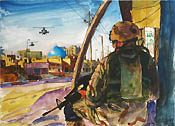 Steve Mumford, an embedded artist in Iraq, has a selection of his watercolors on display in this month's Harper's: "inspired by Winslow Homer's coverage of the Civil War for Harper's Weekly, Mumford made four trips to Iraq in 2003 and 2004 to chronicle military and civilian life."
Steve Mumford, an embedded artist in Iraq, has a selection of his watercolors on display in this month's Harper's: "inspired by Winslow Homer's coverage of the Civil War for Harper's Weekly, Mumford made four trips to Iraq in 2003 and 2004 to chronicle military and civilian life."
His beautifully crafted watercolors depict every aspect of the occupation and insurgency: bound prisoners, soldiers on patrol and relaxing, protests, streetlife, landscapes marred by battle under a serene and cloudless sky.
More work can be seen on-line at artnet.com

Gunner Palace
Hitting theaters March 4th is this much maligned and much anticipated documentary, an inside look at daily life for the 400+ American soldiers operating out of one of Saddam's bombed out palaces in Baghdad.
Excerpt
GUNNER PALACE reveals the complex realities of the situation in Iraq not seen on the nightly news. Told first-hand by our troops, 'Gunner Palace' presents a thought provoking portrait of a dangerous and chaotic war that is personal, highly emotional, sometimes disturbing, surprisingly amusing ... and thoroughly fascinating.

Filmmaker Michael Tucker, who lived with 2/3 Field Artillery, a.k.a. "The Gunners" for two months, captures the lives and humanity of these soldiers whose barracks are the bombed-out pleasure palace of Uday Hussein (nicknamed Gunner Palace), situated in the heart of the most volatile section of Baghdad. With total access to all operations and activities, Tucker's insider footage provides a rare look at the day-to-day lives of these soldiers on the ground -- whether swimming in Uday's pool and playing golf on his putting green or executing raids on suspected terrorists, enduring roadside bombs, mortar attacks, RPGs and snipers.
~ from www.gunnerpalace.com
Baghdad Diaries
This diary, compiled by Gunner Palace directors Mike Tucker and Petra Epperlein, consists of notes from the production of the film in 2003-2004 and emails sent from 2/3 FA soldiers during their 410 day deployment to Baghdad and Najaf.
Excerpt
September 14, 2003: An Adult Paradise
My driver took me to Adhamiya today. Ironically, he lives across the street from the Palace, so he promised to check in on me to make sure that I'm OK. Only in Iraq: he's worried about me.
It feels good to be out of the hell called Central Baghdad. It feels like I spent the last week waiting in traffic.
Without any fanfare, I was let into the Palace and given a tour. It's amazing--you couldn't build a better location. The main building, a gaudy monstrosity with massive columns, was bombed during the "shock and awe". One JDAM went in through an elevator shaft and imploded half the building. The other half is where 2/3 has their Tactical Operations Center.

Operation Truth
By and for vets of OIF/OEF (Operation Iraqi Freedom & Operation Enduring Freedom), this where you can hear first-person accounts about the war in Iraq and Afghanistan from the people who were there. The site posts stories written by Servicemembers who have a first-hand perspective about the war in Iraq and Afghanistan. It's mission is to help us understand issues facing our troops and how these issues influence both the safety of the troops and the situation back home.
Excerpt

In the beginning we would get ambushed a few times in Sadir City. Over a period of time we established several police stations and worked closely with the Iraqi Police to get them out and about to enforce the law. It was a lot safer when we left than it was when we first got there. It is worse now than before we even stepped foot in Baghdad. About the insurgents: Most of these insurgents we always hear about are nothing more than outraged Iraqis that are up in arms about our occupation. I am all for getting the Iraqis back on track but to sit here and see everything we did go to pot does not tell me that we are making progress.
Homeland Security Index
Harper's January '05 Index lists some intriguing facts reguarding suspected terrorists in detention, Iraqi mortality rates, the G.I. Rights Hotline and Martin Luther King Jr.'s birthday.
Posted on Wednesday, February 2, 2005
Years since the Justice Department last released the number of U.S. terror suspects taken into "preventive detention" : 3
Estimated number of people who have been taken into such detention since then : 4,000
Minimum number of Al Qaeda suspects from overseas whom the United States has now "disappeared," by legal standards : 11
Percentage "more intelligence" given up by prisoners in Iraq since coercion of them was banned, according to a U.S. general : 25
Factor by which an Iraqi is more likely to die today than in the last year of the Hussein regime : 2.5